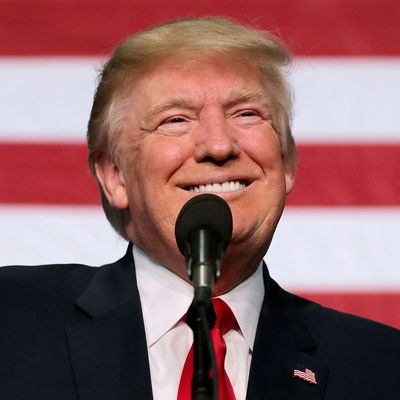
Hillary Clinton campaigned on an infrastructure plan that included a $25 billion seed investment in an “infrastructure bank.” Donald Trump’s campaign assailed that proposal, describing it as a nefarious, wasteful entity that would be “controlled by politicians and bureaucrats in Washington.”
But now, Trump’s favorite politicians and bureaucrats in Washington — the members of his transition team — are floating the “infrastructure bank” idea as their own. Per Bloomberg:
Steven Mnuchin, a member of the team’s executive committee who was recommended for the position of Treasury secretary, said in brief comments to reporters Wednesday that a “very big focus is regulatory changes, looking at the creation of an infrastructure bank to fund infrastructure investments.”
At various points in the campaign, Trump called for a massive infrastructure stimulus, ostensibly including direct federal spending. In one instance, he even promised to spend twice as much on infrastructure as Hillary Clinton was proposing.
But Trump’s actual, official infrastructure plan involves no direct federal spending. Instead, the president-elect aims to inspire $1 trillion of private investment in infrastructure projects, by offering $137 billion in federal tax breaks to prospective investors.
As a plan for fixing America’s “crumbling roads and bridges,” this proposal has one main flaw — it would do nothing to fix America’s “crumbling roads and bridges.” Per Vox’s Brad Plumer:
All Trump has right now is an idiosyncratic proposal for Congress to offer some $137 billion in tax breaks to private investors who want to finance toll roads, toll bridges, or other projects that generate their own revenue streams. But this private financing scheme, experts across the political spectrum say, wouldn’t address many of America’s most pressing infrastructure needs — like repairing existing roads or replacing leaky water mains in poorer communities like Flint. It’s a narrow, inadequate policy.
For instance: “This is unlikely to do much for road and bridge maintenance,” notes Harvard economist Edward Glaeser. “And [economists] have long believed that the highest returns are for fixing existing infrastructure.”
The problem here is that private investors need bang for their buck. New roads and bridges in populous areas — where high tolls and user fees can be charged — will provide that bang. But renovating existing toll-free roads, or improving municipal bus systems, or restoring safe, clean drinking water to residents of Flint, Michigan, won’t.
Infrastructure banks — which fund projects via longterm bonds — don’t really solve this problem either. Which is why $250 of Clinton’s $275 billion infrastructure plan was devoted to direct federal spending.
But a proposal to directly invest taxpayer money into public goods is to House Republicans as nails across a chalkboard is to normal humans — it causes them to grimace and cover their ears.
Unless, Trump and Steve Mnuchin have a plan to overcome that knee-jerk opposition, America’s roads and bridges will keep a’crumbling.






























